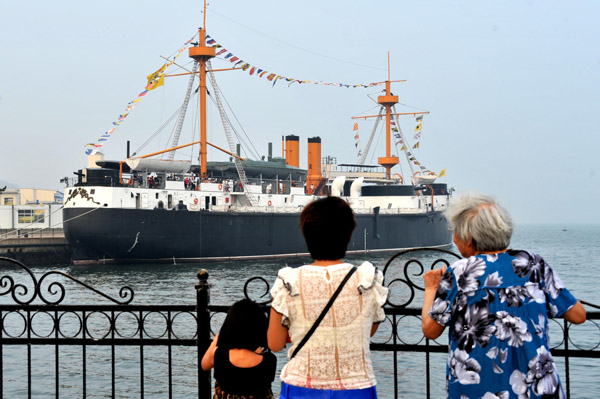The war that changed Asia
|
Tourists examine a model of the Dingyuan, a member of the Beiyang Fleets, in Weihai, Shandong province.Xu Suhui / Xinhua |
The calm waters of the Yellow Sea, an area of ocean in the far north of the East China Sea, were the venue for the largest naval battle in the First Sino-Japanese War (1894-95).
On Sept 17, 1894, 12 ships from the Beiyang Fleet sailed into a dense volley of cannon fire from the Imperial Japanese Navy off the coast of Dadonggou, Liaoning province.
By the end of the battle, China had lost four cruisers and more than 1,000 men, while only a few hundred Japanese sailors had been injured and four ships had sustained damage.
"It was a disaster for the Chinese fleet," said Chen Yue, president of the Chinese Naval Historical Institute who specializes in the studies of the conflict.
Pressing home their advantage, the Japanese won two more battles in the following months - at Lushunkou, Liaoning, and Weihaiwei, Shandong province, the place where the Beiyang Fleet was born and ultimately annihilated, and is now known simply as Weihai.
At the conclusion of the war, China had to sign the Treaty of Shimonoseki, under which the country had to pay reparations, cede Taiwan and the Liaodong peninsular in Liaoning province to Japan, and recognize the independence of Korea.
"It was a war that changed Asia forever," Chen said. "It gave Imperial Japan the confidence and military assets, such as the captured armored cruiser Zhenyuan, to defeat the Russian Empire in 1904, paving the way for the colonization of the Korean Peninsula and northern China."
Chen believes the defeat taught China many painful but valuable lessons - namely that a strong navy requires a solid sociopolitical foundation as well as advanced technology and combat-tested military discipline.
For thousands of years, China viewed its 18,000-kilometer coastline as a "natural Great Wall", he said. "Before Great Britain, no nation had invaded China via the sea, so, as a result, the army held most of the resources and senior posts because inland threats were far more common."
Li Hongzhang, a politician and one of the leaders of a modernization movement during the Qing Dynasty (1644-1911), had to fight political battles to gain support for the Beiyang Fleet. Still, the Qing's political elite was skeptical and China had suffered great losses in terms of economics and morale after the Opium Wars (1839-60). "Li simply did not have the sociopolitical support to build a modern navy," Chen said.
Li's methods of modernization left much to be desired. Using the theory "learning from the enemy to beat the enemy", he spent enormous amounts westernizing his fleet, including purchasing foreign-made warships, training sailors overseas and adopting Western culture.
However, even as the Beiyang Fleet was being completed in the late 1880s, it was already beginning to fall behind the rest of the world, as Chen noted. "It was the strongest navy in Asia by the standards of previous generations, but the world's naval technology and doctrines had moved on from 'big ships, big guns' to 'fast ships, fast guns'. Firing speed, mobility and volley density were the new normal," he said.
The technological gap was the deciding factor in the battle in the waters off Dadonggou. The Chinese ships were bulky and slow. It took 15 minutes for the Zhenyuan's 12-inch cannon to fire once, while the smaller cannons used by the Japanese could fire five times per minute, according to Chen: "The Japanese sailors could stride leisurely on their deck, while fire and chaos consumed everything on the Chinese side."
Before the battle, the foreign press was certain of a Chinese victory because the two armored ships - the Dingyuan and the Zhenyuan - were fitted with superior armor and their firepower was unmatched by the Japanese navy. Despite that, Li was aware of the outdated technology and philosophy of the Beiyang Fleet, but was unable to remedy the situation because he had overspent and had made too many enemies, Chen said.
In modern China, though, naval development has been given unprecedented emphasis, both financially and politically, he added.
"With its economic size and global initiatives, China has the ability and the need to develop a strong navy to protect its growing interests overseas. A strong navy is a natural milestone in any country's ascent to global power - that has been the case for every colonial power and the United States," he said.
"The only way to test technology and doctrine is through actual combat, which is something the Chinese navy is attempting to emulate through increasingly complex drills in multiple sea environments," he said. "After all, wars are not won on paper."





















